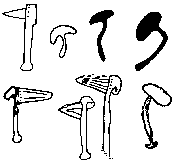Deus ex Machina
from www.timesonline.co.uk
from the article:
Ghosts in a machine
For years brain researchers shied away from exotic experiences such as hallucinations, near-death experiences or “intimations of the divine”, on the grounds that there was no way to study them scientifically. But as consciousness has become an academically respectable topic, it has become harder to ignore “altered states”. If memory and imagination can be linked to the activity of groups of neurons, couldn ’t the experience of being “at one with the universe” just be the result of brain cells firing?
Traditionally, one of the ways to stimulate these experiences has been with hallucinatory or psychedelic herbs and drugs — a route that has been declared legally off-limits for individuals and researchers since the 1960s. But that is changing, too. Recently licences have been granted in the USA to study the medical benefits of using such outlawed drugs as Ecstasy and the peyote mushroom to treat psychological conditions such as post-traumatic stress disorder and obsessive-compulsive disorder.
It may be a sign of the times that just before Christmas the US Supreme Court ruled that members of the New Mexico branch of a Brazilian church, Uniao Do Vegetal, should be allowed to use the hallucinatory herbal concoction ayahuasca in ceremonies. Ayahuasca has long been used by South American shamans and is renowned for the snake visions it induces.
The poet Allen Ginsberg tried it in the 1950s in an attempt to expand his consciousness. “I rushed out and began vomiting,” he wrote, “all covered with snakes, like a Snake Seraph, coloured serpents in an aureole around my body, I felt like a snake vomiting out the universe.”
Uncovering how a complex chemical stew triggers something as specific as serpentine visions would be a daunting scientific challenge, let alone identifying precisely which regions of the brain were involved. But for at least 100 years neurologists have been recording the bizarrely detailed altered states produced by very specific activity in the brains of epileptics. Recently, observations on epileptics have provided clues to the neural mechanism underlying out-of-body experiences (OBEs).
(snip)
“What researchers are finding is that there seem to be common brain pathways underlying all transcendental experiences,” she says. “It’s the cultural interpretations that vary. But what’s really challenging is that the research evidence is very strong that what we think of normal everyday reality is actually a construction of the brain.
“However, it is quite clear that the brain is also able to construct a version of reality that is quite unlike the survival-orientated ‘normal’, one. Now why on earth should it have evolved to do that and why is our culture so dead set against exploring it?”
 the world is what we make it
the world is what we make it























